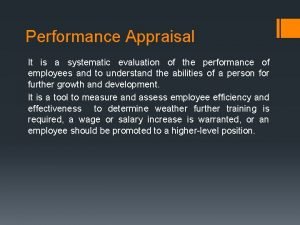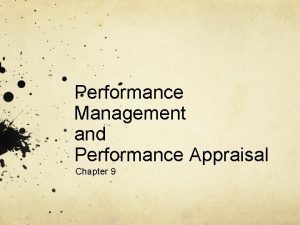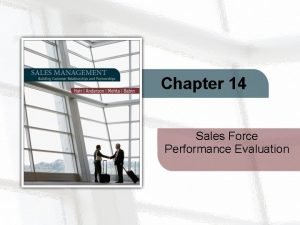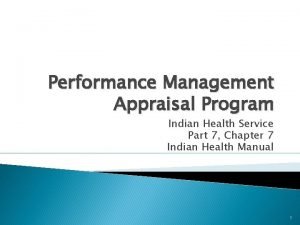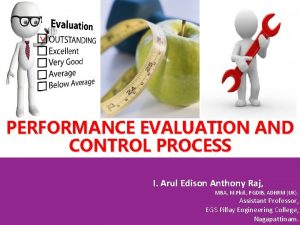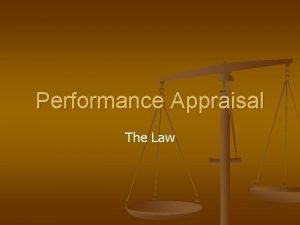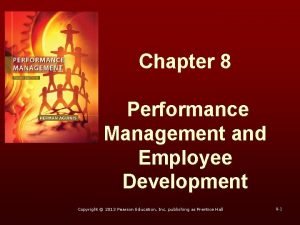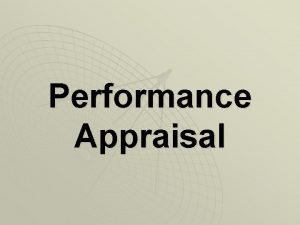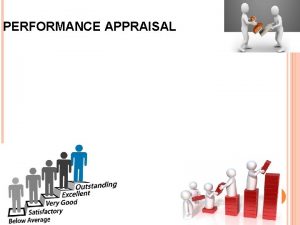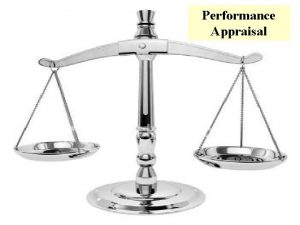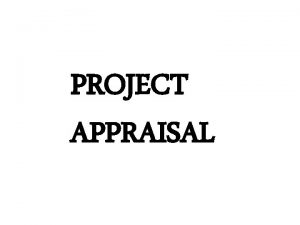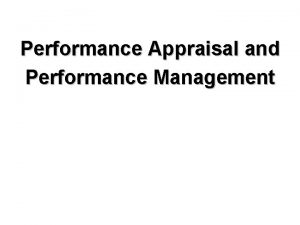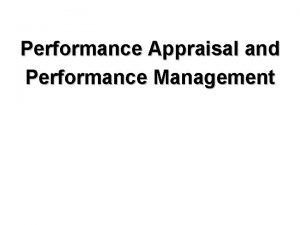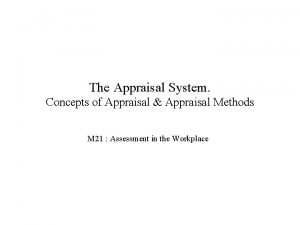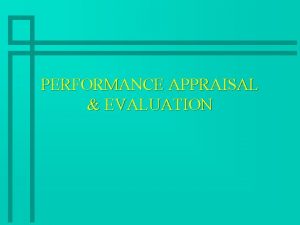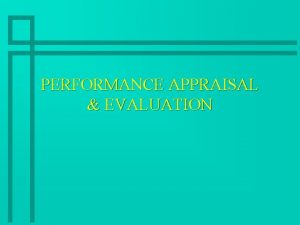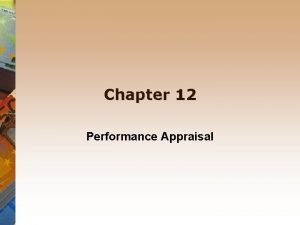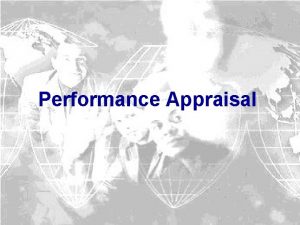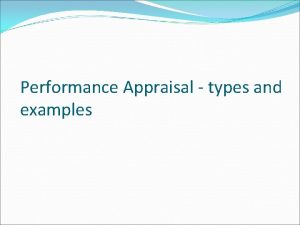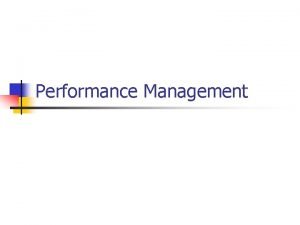Performance Appraisal It is a systematic evaluation of















- Slides: 15

Performance Appraisal It is a systematic evaluation of the performance of employees and to understand the abilities of a person for further growth and development. It is a tool to measure and assess employee efficiency and effectiveness to determine weather further training is required, a wage or salary increase is warranted, or an employee should be promoted to a higher-level position.

Objectives § To identify the strength and weaknesses of employees. § To improve the organization’s productivity. § To maintain records in order to determine wage structure, compensation package, salary raises, job promotion, job changes, termination etc. § To provide feedback to employees on their performance and related status. § To review and introduce promotional and other training programmes. § It serves as a basis for influencing working habits of the employees.

4 Goals of Performance Appraisal • Individual needs • Performance feedback • Transfers • Strengths and development needs. • HR Planning • Training needs • HR system evaluation • Goal Identification Developmental Use Administrative Uses Organizational Maintenance Use Documentation Purpose • Salary • Promotion • Termination/Retenti on • Recognition /Rewards • Poor performance identification • Validation Research • HR Decisions • Legal Requirements

Benefits of Performance Appraisal § Promotion § Compensation § Employees development § Selection validation § Motivation

Methods/Techniques/Systems of Performance Appraisal 1. Rating Scales : Consists of several numerical scales representing job related performance criterions such as attendance, attitude, output etc. , Each scale ranges from excellent to poor. Advantage : Low cost, suitable to evaluate any job, no training required, Large number of employees coverage. Disadvantage : Rater’s biases Performance Poor Level Attendance Sincerity Behaviour Dependability Fairly Poor Fairly Good Excell ent

2. Forced Choice Method The series of statements are arranged in the blocks of two or more and the rater indicates which statements are most or least descriptive of the employee. The rater is forced to make a choice. Advantages : Absence of personal bias. Disadvantages : Statements maybe wrongly framed Criteria 1. Regularity on the job Always Regular Never Regular Remain Absent Most Least

Paired Comparison Method § In this method each employee and job is compared with each other employee and job. Ex: For the trait “Creativity” Compared to A(Arun) B(Kumar) A (Arun) + B (Kumar) + C (Joel) - + D (Azir) + - + Denotes “Better than Him” - Denotes “Worse than him” C(Joel) D(Azir) + - + +

360 -Degree feedback § Feedback from an employees' subordinates, supervisiors, clients, colleagues as well as a self-evaluation by the employee himself is gathered. Top Management Peers / Colleagues Employee Subordinates Self

Checklist Method In this method, a list of statement that describe the characteristics and performance of the employees on the job are given. The rater indicates the positive or negatives to each statement. Example 1. Is regular on the job ? □ Yes □ No 2. Is interested in the job ? □ Yes □ No 3. Keeps making mistakes ? □ Yes □ No 4. Does maintain discipline ? □ Yes □ No

Essay Appraisal § The rater answers a series question about the employee in essay form. The statement may include strengths and weaknesses or statement about past performances. § Disadvantage : The writing ability of the manager can influence the performance both in negative and positive ways. § Advantage : Elaborate answers can be given about an employee performance. Example: Employee Name : Ms. Asha Title : CSE Department : Sales Attribute What does this employee do well ? Describe the performance Challenges. Areas that the employee should improve and why ? Comments

Critical Incidents Method Developed by Flanagan and Burns. In this method, the manager prepares lists of statement of very effective and ineffective incidents representing outstanding and poor behaviour on the job. The manager maintains logs on each employee in the form of periodical records. At the time of rating/appraisal, the logs are used to evaluate the employee. Example : C. I. Log of Mr. Zayin, Sales Clerk August 21 – The sale clerk patiently attended to the customers complaint. September 01 – He failed to attend the store manager’s call thrice. He is lazy, negligent and uninterested in his job.

Confidential Report System Well known method used by Government organizations and in the Indian Judiciary. Subordinates are observed by the superiors regarding the performances and the duties done on the job. Thereafter the superior writes a confidential report which will not be revealed to anyone and finally forwarded to the top management for decision making related to Promotions and Transfer. Key Factors Accessed § Character and conduct § Absenteeism § Job knowledge § Punctuality § Behaviour with colleagues, Supervisors and with the public § Ability to supervise and control § Integrity and honest § Complaints against the employee

Factors affecting performance appraisal 1. The Halo Effect : A worker who is who or outstanding in one or two areas will receive a “halo”. His supervisor believes he is good in all areas because of few strong points. Similarly, a worker who is seen as weak in one or two areas or can get saddled with “horns”. His supervisor will overlook his strong points. 2. The Matthew Effect : Similar to halo effect but it is more permanent. Most of the times a employee is judged based on the early performance appraisal. If positively appraised last time, he/she will be trusted more, which can affect the current performance appraisal. 3. Standards of Evaluation : Many organizations use subjective terms like “poor, excellent, fair, good to characterise performance. But this may mean different things to different people.

4. General Biases : Evaluator’s leniency would rate the employee fairly high or tendency to rate everyone as average. Evaluators sometimes looks at recent performance to rate an employee thus exhibiting recency bias. § Conduct of performance appraisal to punish the low performers / non-performers. § Usage of fundamentally flawed performance appraisal tools. § Focussing on encouraging a particular individuals which discourages other individuals esp. in team or collaborative work. § Monologues instead of dialogues in feedback. § Misguidance to the appraiser.

Thank You
 Performance management vs performance appraisal
Performance management vs performance appraisal Behaviorally anchored rating scales
Behaviorally anchored rating scales Contoh critical appraisal jurnal systematic review
Contoh critical appraisal jurnal systematic review This is the systematic evaluation of the employees
This is the systematic evaluation of the employees What is graphic rating scale
What is graphic rating scale Evaluation of sales force
Evaluation of sales force Swot analysis of performance management system
Swot analysis of performance management system Planning appraisal example
Planning appraisal example Performance management appraisal program
Performance management appraisal program Pirl in performance appraisal
Pirl in performance appraisal The purpose of
The purpose of Seafarer performance appraisal
Seafarer performance appraisal Legal issues in performance appraisal
Legal issues in performance appraisal Goda plan
Goda plan Employee development
Employee development Methods of performance appraisal
Methods of performance appraisal



